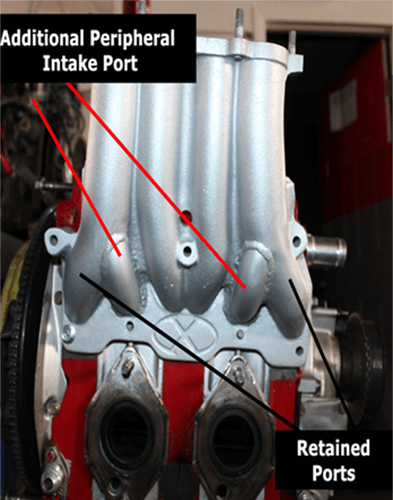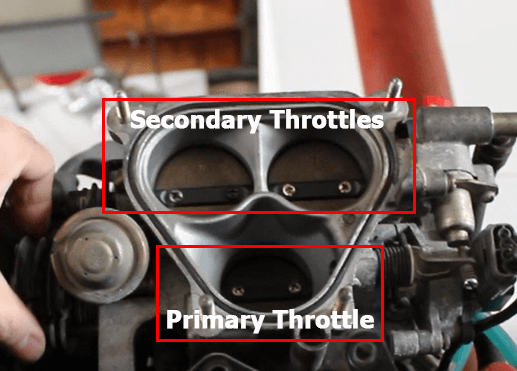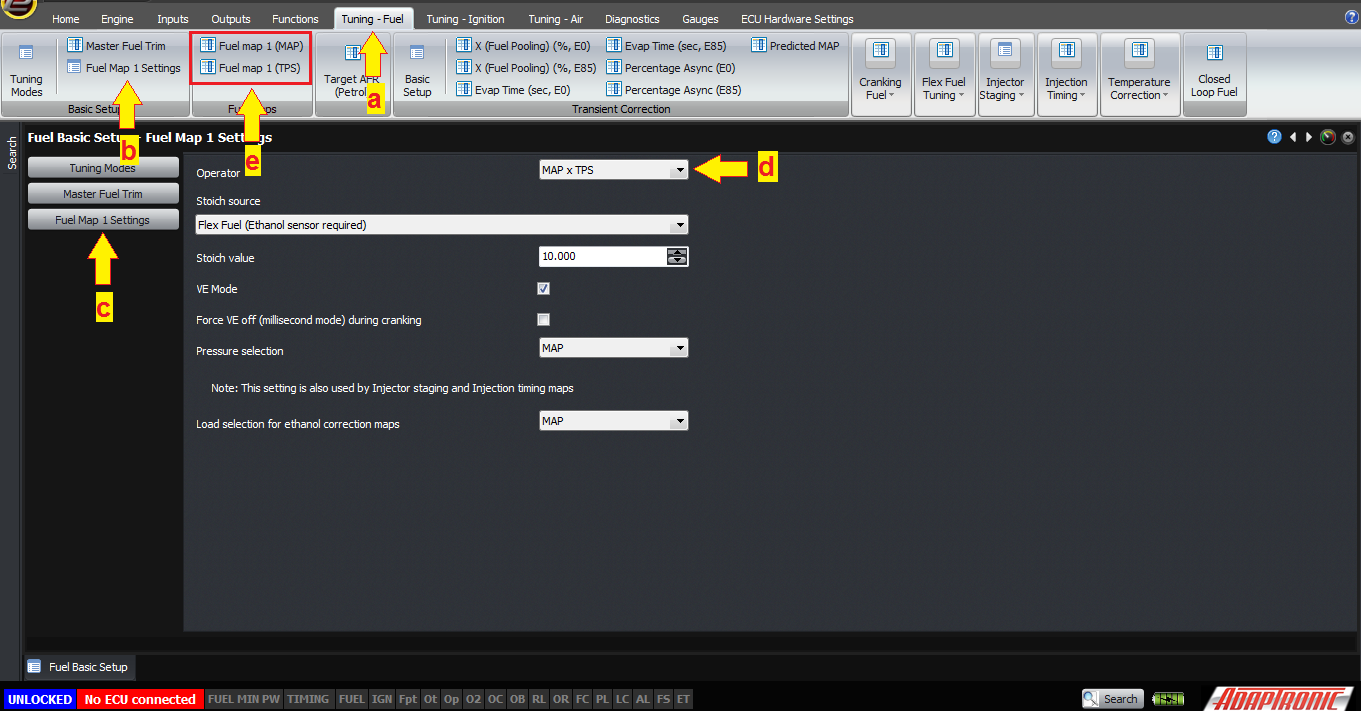Semi-Peripheral Rotary Tuning

Once one of our dealers was tuning what’s
commonly called a semi peripheral 13B engine. For those not
familiar with this porting arrangement, this is a standard 13B
2-rotor engine, where the two side intake ports are retained,
but an additional peripheral intake port is added. So each rotor
has 3 intake ports.

If you’ve looked at a standard FD intake manifold, you’d have seen that each of the side inlet ports has its own runner, so there are 4 runners in total. On a semi peripheral intake manifold, the peripheral port gets its air from the original runner for the secondary port.
This engine had a Borg Warner turbocharger so it was making about 5 PSI of boost around 2000 RPM, even at about 30% throttle. The engine could be tuned correctly for this condition, but then when the throttle was opened to 100%, it was lean, and needed about another 20% more fuel.
Why would this be? If the pressure in the inlet manifold is the same, why would the engine need different amounts of fuel? This doesn’t usually happen. Originally I thought there might be something funny with the car, or there was fuel pressure pulsation or something strange.
But within a few minutes of trying it on the dyno myself and looking at the engine, I worked it out. The FD has staged throttles; the first 30% or so of travel only opens the primary throttle, which provides air to the primary ports only. The remainder of the travel opens up the secondary throttles, which provide air to the secondary ports. Therefore, the port timing depends on throttle position.

And we all know what that means, when you have a turbocharged engine where the VE changes with TPS independently from boost, it means the engine has to be tuned by MAP x TPS.

(a) Go to Tuning Fuel. (b) and (c) Click on Fuel Map 1 Settings. (d) Set the operator to MAPxTPS (e) You will notice Fuel map for MAP will appear together with Fuel map for TPS.
Now, there are a few ways you can do this. The way I chose to do it was to tune the MAP based on the primary throttle, and the TPS map tells the ECU how much better the engine breathes as the secondary throttles are opened.
The way to do this is to lock the secondary throttles so that they don’t open. This can either be done by manually closing the second throttles which are normally under ECU control, or removing the linkage that opens the second throttles. Then set the TPS map to 100% everywhere, and tune it up on MAP as per usual, up to wastegate boost pressure.
Then re-enable the secondary throttles, and then adjust the TPS map to get the correct mixtures, again up to wastegate pressure. Then as you increase the boost, make corrections on the pressure based map.
This tuned up excellently on several of these that I’ve helped tune. Depending on the exact porting though, it might be possible that drivability is not going to be great a certain low RPM / high throttle openings, due to intake reversion. In this case, the options are to either drive around it, or better is to retain the ECU control over the secondary throttles, using a vacuum tank, check valve and a solenoid valve as on the factory system. Then when the solenoid is activated and vacuum is applied to the diaphragm, the secondary throttles close. So the ECU can be configured to hold this output low when the RPM is below say 3000 or wherever the problem area finishes.

We would like to thank these people; Ric Shaw, Aaron Parker and Alex Rodriguez for giving us visuals on some parts of their car.
Thank you and happy learning!

If you’ve looked at a standard FD intake manifold, you’d have seen that each of the side inlet ports has its own runner, so there are 4 runners in total. On a semi peripheral intake manifold, the peripheral port gets its air from the original runner for the secondary port.
This engine had a Borg Warner turbocharger so it was making about 5 PSI of boost around 2000 RPM, even at about 30% throttle. The engine could be tuned correctly for this condition, but then when the throttle was opened to 100%, it was lean, and needed about another 20% more fuel.
Why would this be? If the pressure in the inlet manifold is the same, why would the engine need different amounts of fuel? This doesn’t usually happen. Originally I thought there might be something funny with the car, or there was fuel pressure pulsation or something strange.
But within a few minutes of trying it on the dyno myself and looking at the engine, I worked it out. The FD has staged throttles; the first 30% or so of travel only opens the primary throttle, which provides air to the primary ports only. The remainder of the travel opens up the secondary throttles, which provide air to the secondary ports. Therefore, the port timing depends on throttle position.

And we all know what that means, when you have a turbocharged engine where the VE changes with TPS independently from boost, it means the engine has to be tuned by MAP x TPS.

(a) Go to Tuning Fuel. (b) and (c) Click on Fuel Map 1 Settings. (d) Set the operator to MAPxTPS (e) You will notice Fuel map for MAP will appear together with Fuel map for TPS.
Now, there are a few ways you can do this. The way I chose to do it was to tune the MAP based on the primary throttle, and the TPS map tells the ECU how much better the engine breathes as the secondary throttles are opened.
The way to do this is to lock the secondary throttles so that they don’t open. This can either be done by manually closing the second throttles which are normally under ECU control, or removing the linkage that opens the second throttles. Then set the TPS map to 100% everywhere, and tune it up on MAP as per usual, up to wastegate boost pressure.
Then re-enable the secondary throttles, and then adjust the TPS map to get the correct mixtures, again up to wastegate pressure. Then as you increase the boost, make corrections on the pressure based map.
This tuned up excellently on several of these that I’ve helped tune. Depending on the exact porting though, it might be possible that drivability is not going to be great a certain low RPM / high throttle openings, due to intake reversion. In this case, the options are to either drive around it, or better is to retain the ECU control over the secondary throttles, using a vacuum tank, check valve and a solenoid valve as on the factory system. Then when the solenoid is activated and vacuum is applied to the diaphragm, the secondary throttles close. So the ECU can be configured to hold this output low when the RPM is below say 3000 or wherever the problem area finishes.

We would like to thank these people; Ric Shaw, Aaron Parker and Alex Rodriguez for giving us visuals on some parts of their car.
Thank you and happy learning!
©2018 Adaptronic